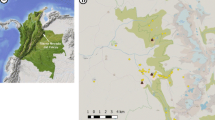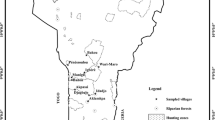Abstract
In coastal and highland Peru, totora,Schoenoplectus californicus (C. A. Meyer) Soják (Cyperaceae), has played a central cultural role. Totora was used to build boats, houses, bridges, mats, containers, clothing, string, and fans and has been noted for its use as both food (for humans and livestock) and fertilizer. We conducted unstructured interviews in Spanish and followed participant observation methods in Huanchaco and Lake Titicaca located in coastal and highland Peru, respectively. We hypothesized that a plant with high saliency to the local culture would have a high level of associated indigenous conservation practices. In addition, the level of care and management should increase as the resource became more valued or increasingly scarce. We found that, despite a long established tradition of sustainable use, the people were increasingly relying on intensive cultivation of this plant. The value of totora to local residents justified the efforts spent in maintaining adequate supplies of this plant. Increases in population, politics, and yearly variation in climate patterns have created a reduction in available totora and contributed to an increase in management practices.
Resumen
La totora,Schoenoplectus californicus (C. A. Meyer) Soják (Ciperáceas) ha tenido un rol central y cultural en la costa y en la sierra del Perú. La totora ha sido utilizada para construir balsas, casas, puentes, esteras, cajas, cuerdas, y abanicos. También, se ha notado el uso de la totora como fuente de alimentación (para el hombre y el ganado) y fertilizante. Pronosticamos que una planta de gran importancia en la cultura local, estaría sumamente ligada con prácticas indígenas de conservación. Asimismo, pronosticamos que el nivel de cuidado y manejo de totora aumentaría si este recurso fuera más valorado o fuera disminuyendo paulatinamente. Realizamos entrevistas inestructuradas en Español e hicimos un seguimiento utilizando métodos de participación y observación en Huanchaco, Trujillo y en el Lago Titicaca, Puno. Encontramos que a pesar de que ha existido una larga tradición de uso sostenible de la totora, la gente ha incrementado su dependencia en la totora, intensificado su cultivo. Para los residentes locales, el valor de la totora, justifica los esfuerzos invertidos en mantener una adecuada reserva de esta planta. Pero el aumento de la población, los problemas politicos, y la variación anual de patrones climáticos, han creado una reducción en la disponibilidad de la totora y a su vez han contribuido al aumento de prácticas de manejo y conservación de la totora.
Similar content being viewed by others
Literature Cited
Acosta, J. de. 1970. Historia Natural. The natural and moral history of the Indies. Reprinted from the English translated edition of Edward Grimston, 1604, and edited with notes and an introduction by Clements R. Markham. Vol. 1. B. Franklin, New York, USA
Adams, C. D. 1994. Cyperaceae. Pages 402–485 in G. Davidse, M. Sousa, and A. O. Chater, eds., Flora Mesoamericana, Vol 6. Universidad Nacional Autónoma de México, Mexico, D.F., Mexico, Missouri Botanical Garden, St. Louis, Missouri, and The Natural History Museum, London, England.
Beetle, A. A. 1941. Studies in genusScirpus L. III. The American species of the sectionLacustres Clarke. American Journal of Botany 28:691–700.
Bennett, W. 1946. The Andean civilizations. Pages 1–147 in J. H. Steward, ed., Handbook of South American Indians, Bureau of American Ethnology, Bulletin 143(2). Smithsonian Institution, Washington, D. C.
Brako, L., andJ. L. Zarucchi. 1993. Catalogue of the flowering plants and gymnosperms of Peru, Monographs in Systematic Botany, Missouri Botanical Garden 45:i-xl,-1286.
Cobo, B. 1990. Historia del Nuevo Mundo. Capítulo 13-14. English. Inca Religion and Customs. Translated and edited by R. Hamilton. University of Texas Press, Austin, TX, U.S.A.
Forman, S. H. 1977. The totora in Colta lake; an object lesson on rapid cultural change. Ñawpa Pacha 15:111–116.
Heiser, C. B. 1974. Totoras, taxonomy, and thor. Plant Science Bulletin 20:22–26.
—. 1978. The totora(Scirpus californicus) in Ecuador and Peru. Economic Botany 32:222–236.
—. 1985. Of plants and people. University of Oklahoma Press, Norman, U.S.A.
Kautz, R. R., andR. W. Keatinge. 1977. Determining site function: a north Peruvian coastal example. American Antiquity 42:86–97.
King, A. S. M., andJ. R. Flenley. 1989. The late Quaternary vegetational history of Easter Island. University Hull, School of Geography and Earth Resources Miscellaneous Series 31:1–24.
Koyama, T. 1963. The genusScirpus Linn. Critical species of the sectionPterolepis. Canadian Journal of Botany 41:1107–1131.
La Barre, W. 1948. The Aymara indians of the lake Titicaca plateau, Bolivia. American Anthropological Association Memoir No. 68.
Lange, P. J., R. H. de, Gardner, P. D. Champion, andC. C. Tanner. 1998.Schoenoplectus californicus (Cyperaceae) in New Zealand. New Zealand Journal of Botany 36:319–327.
Macía, M. J., andH. Balslev. 2000. Use and management of totora(Schoenoplectus californicus, Cyperaceae) in Ecuador. Economic Botany 54:82–88.
Murphy, R. C. 1923. The oceanography of the Peruvian littoral with reference to the abundance and distribution of marine life. Geographical Review 13:64–85.
Orlove, B. 1991. Mapping reeds and reading maps: the politics of representation in Lake Titicaca. American Anthropologist 18:3–38.
Parsons, J. R. 1968. The archeological significance ofmahames cultivation on the coast of Peru. American Antiquity 33:80–85.
—, andN. P. Psuty. 1975. Sunken fields and prehispanic subsistence on the Peruvian coast. American Antiquity 40:259–282.
Ravines, R. 1975. Tecnologia Andina. Instituto de Estudios Peruanos, Lima, Peru.
Rondón, X. J., S. A. Banack, andW. Diaz-Huamanchumo. 2003.Ethnobotanical investigation of caballitos(Schoenoplectus californicus: Cyperaceae) in Huanchaco, Peru. Economic Botany 57: 35–47.
Rowe, J. H. 1969. The sunken gardens of the Peruvian coast. American Antiquity 34:320–325.
Rostworowski, M. 1981. Recursos Naturals Renovables y Pesca, Siglos XVI y XVII. Ed. 1. Instituto de Estudios Peruanos, Lima, Peru.
Sagastegui-Alva, A. 1960. Cíperaceas de la provincia de Trujillo. Revista Universitaria [Trujillo, Peru] 3ra Epoca, Año X, Nos. 17–18:153–185.
Smith, R. T. 1979. The development and role of sunken field agriculture on the Peruvian coast. Geographical Journal 145:387–400.
Spradley, J. P. 1980. Participant Observation. Harcourt Brace Jovanovich College Publishers, Fort Worth.
Tresierra-Aguilar, A., E. Alvitez-Izquierdo, andE. Diaz-Carranza. 1994. Cultivo deSchoenoplectus californicus “Totora” y el efecto de las lagunas de oxidación sobre los totorales de la caleta de Huanchaco (Trujillo-Peru). Rebiol 14(l–2):81–94.
Tschopik, H. Jr. 1946. The Aymara. Pages 501-573 in J. H. Steward, ed., Handbook of South American Indians, Bureau of American Ethnology, Bulletin 143(2): Smithsonian Institution, Washington D.C.
Vega, G. de la. 1985. Comentarios Reales de los Incas. Editión al cuidado de César Pacheco Vélez. Banco de Crédito del Perú, Lima, Peru.
Vidal-Fernández, J. D., E. Larco-León, M. Ñique-Alvarez, andB. Alva-Pérez. 1993. Conservaciónex situ deSchoenoplectus californicus (C.A. Mey.) Soják en Huanchaco (Trujillo, Perú). Anteonor Orrego 2:17–27.
Author information
Authors and Affiliations
Corresponding author
Rights and permissions
About this article
Cite this article
Banack, S.A., Rondón, X.J. & Diaz-Huamanchumo, W. Indigenous cultivation and conservation of Totora (Schoenoplectus Californicus, cyperaceae) in Peru. Econ Bot 58, 11–20 (2004). https://doi.org/10.1663/0013-0001(2004)058[0011:ICACOT]2.0.CO;2
Received:
Accepted:
Issue Date:
DOI: https://doi.org/10.1663/0013-0001(2004)058[0011:ICACOT]2.0.CO;2




